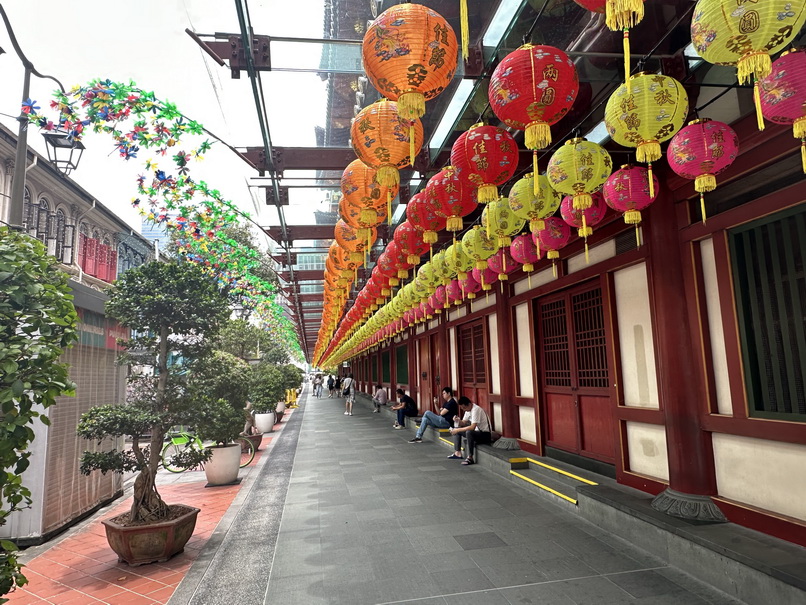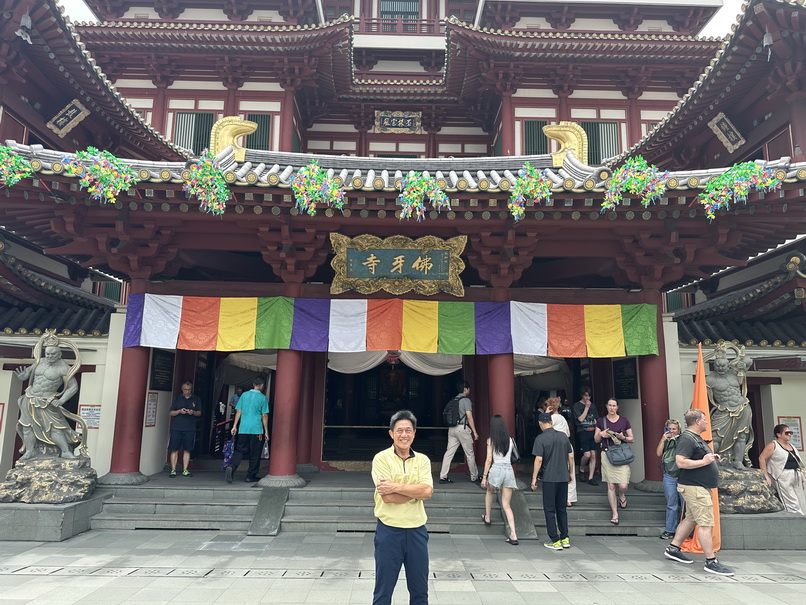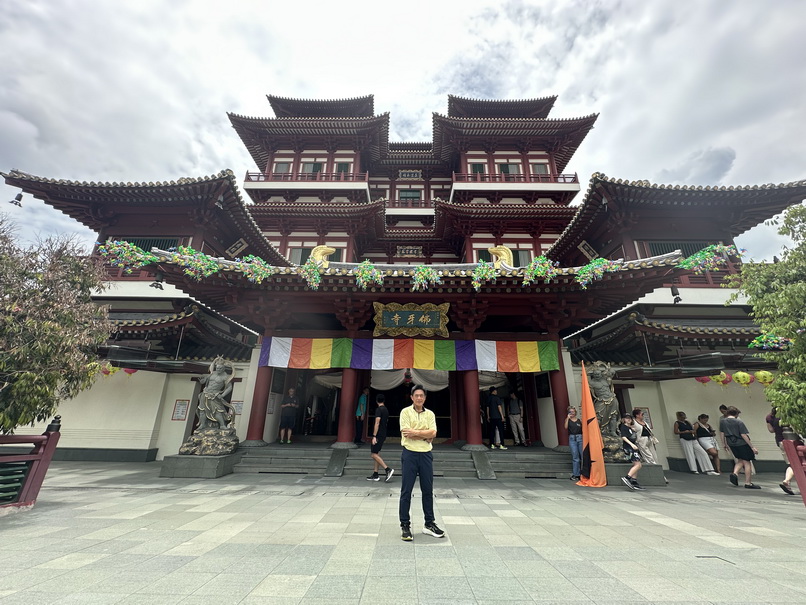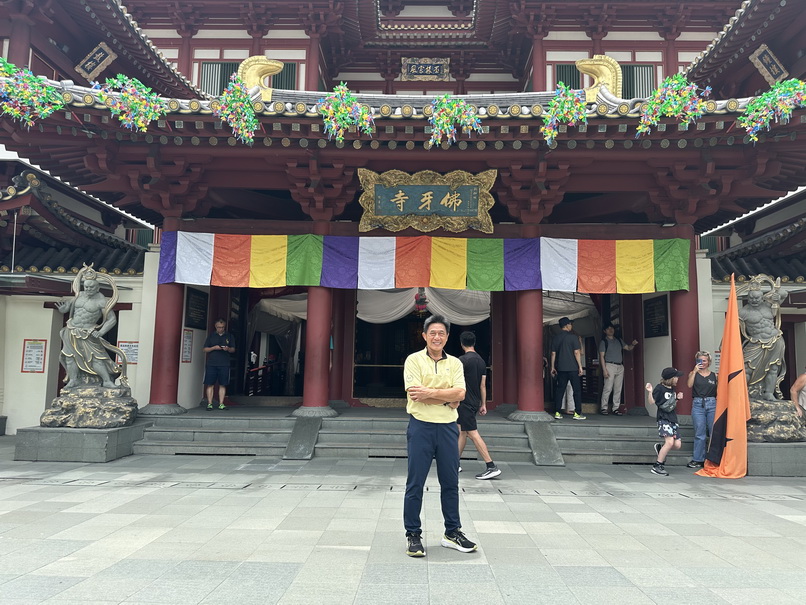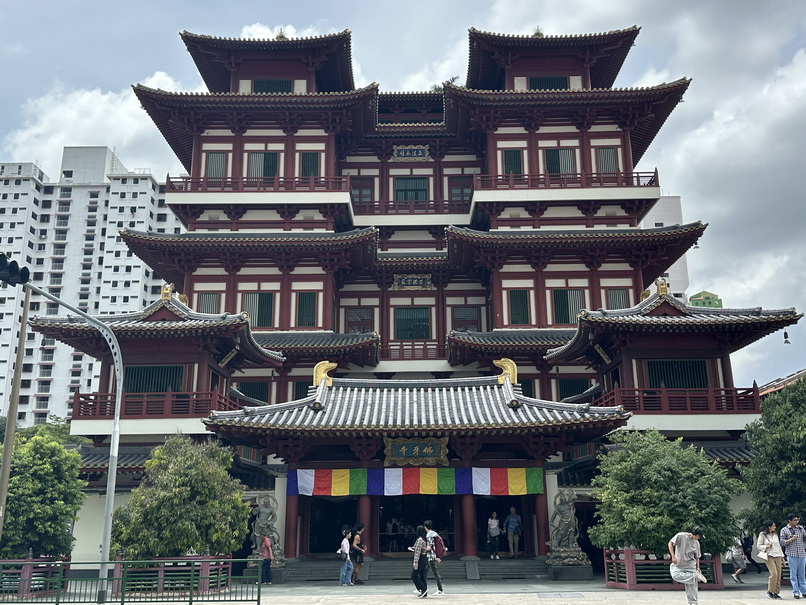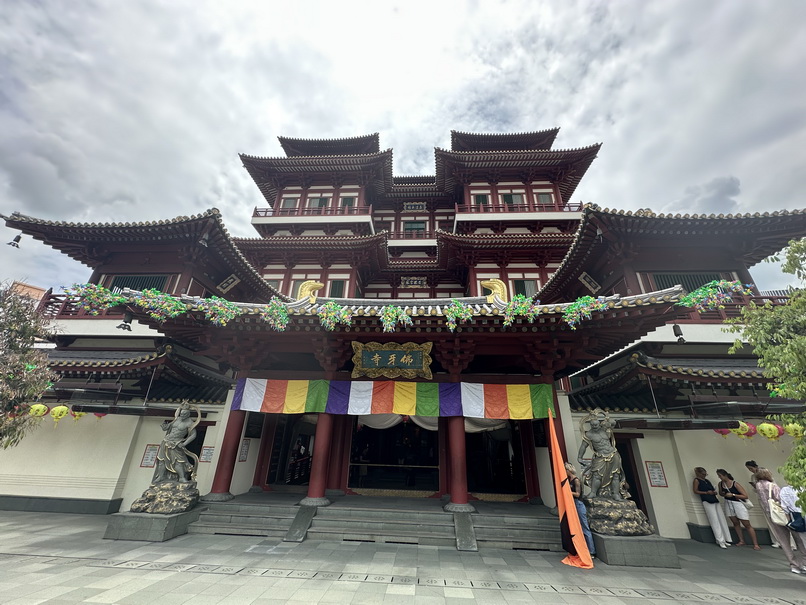|
佛牙寺龙华院的创设主要是为了供奉佛教徒
心中的圣物佛牙舍利,
让我们的信徒有机会瞻仰Zhānyǎng礼拜。
唐朝是中国艺术、文化和建筑的黄金时代。在本地及海外顾问的协助下,佛牙寺龙华院的独特设计大胆地结合了曼荼罗元素Màn
tú luó yuánsù及唐朝建筑风格。
建造佛牙寺龙华院是靠我们的信徒和功德主的慷慨捐赠,
除了新加坡人,海外佛教徒也慷慨解囊。Kāngkǎi
jiěnáng
●
龙华佛牙寺
○
2005年建造,建造耗资Hàozī5300万,
53,000,000
■
左右两相
●
金刚力士(门神),也称为哼哈二将
●
大家看他们两位是什么姿态?
●
怒目而视、六块腹肌Nùmù'érshì,
liù kuài fù jī
●
才能把佛门前的邪气吓走
○
佛牙寺门前有四颗龙华树,这在佛教里面被认为是有保佑平安的说法
○
原名龙华寺,后来因佛牙入驻改名佛牙龙华寺院
○
这颗佛牙来自于缅甸的一间寺庙,在修复寺庙时发现
■
寺院的主持前来新加坡参观时,被法照法师弘扬佛教的贡献所感动,将佛牙交予Jiāo
yǔ法照法师来保管
■
传说,这颗佛牙来自2500多年前释迦牟尼佛陀的火化遗体,被珍藏并辗转流传。bèi
zhēncáng bìng zhǎnzhuǎn liúchuán.
■
刚好法照法师要找地兴建寺院,新加坡政府将这块地批给了法师,兴建了这所佛寺来供养佛牙
■
被金屋藏娇Cáng
jiāo,将佛牙供奉在豪华的金塔内
○
建成后,也为隔壁Gébì的死人街做了一场很大的法式来超度这些亡灵
○
遵循唐代风格Zūnxún
táng dài fēnggé
■
由三个厚重的红漆双扇hóng
qī shuāng shàn大门所组成
■
大门上有金铜制门钉、雕刻包叶以及一对兽面铺首衔环
■
山门也称为三门,通常有三个入口,象征佛教的三解脱门,即通往涅槃的三大途径,分别为空门、无相门和无作门
■
通过三门者能解脱贪、瞋、痴,放下执念
■
请大家猜一下,为什么中间的门封起来了呢?中间大门通常只供贵宾使用

|
|
第一个站点---树下
a.龙华院的名字由来其实和里面供奉的主神-弥勒佛很有关系,相传弥勒佛Mílè
fú就是在龙华树下成道的,门口的这两颗树就是龙华树(指一下)。那佛牙寺,是因为这里供养着一个珍贵的佛牙舍利,据说,见佛舍利如见佛祖本人,佛牙舍利又是最受重视的,
全世界只有七颗,对外开放的只有两颗,新加坡佛牙寺这颗,朝九晚六每天开放。
另外一颗在斯里兰卡,而且只有在指定的日子排很长的队才能看上一眼。
b. 这么珍贵的佛牙舍利,是怎么来的呢?
据说,在
1980年的时候,缅甸妙务著名的寺院般陀喇佛寺的主持务舍葛帕喇和五位信徒一起登上妙务的蒲甘山,修复倒塌dǎotā的佛塔与佛像,在清理过程中他们发现纯金佛塔内藏有一个佛牙及舍利
子。
在2002年初,务舍葛帕喇wù
shě gé pà lǎ应邀前来新加坡参观照法师所创办的护国金塔寺,被发照法师对弘扬佛教的贡献深深感动,便决定将珍藏了而是多年的佛牙舍利,交由法照法师监护,并嘱咐法师,如果可以,希望兴建一座寺庙来供养佛牙,让世界各地佛教信徒都有机会瞻礼佛牙。于是法照法师,开始筹建佛牙寺,选择在这里也是由特殊意义的,一是因为旁边的死人街,建在这里可以超度亡灵;二是因为法照法师从小就从牛车水这一带长大的,对这边很有感情。整个佛牙寺的建造格局,是释法照法师闭关一年,亲自设计规划,在海内外的顾问团队的帮助下得以修建的,2005年动土,耗资7500万新元,于2007年落成,并于当时的总统纳丹亲自揭幕。整个建筑可以说是布局巧妙,而且气势恢宏,接下来我们去里面近距离的看一下。
2.第二个站点: 门口(如果树下很热 ,门口就是第一个站点)
a.
在进去之前,我们看下佛教的护法护院,哼哈二将,
一个闭着嘴巴,从鼻孔里,发出哼的声音,
另一个张着嘴巴,发出哈的声音,来震慑Zhènshè妖魔鬼怪,远离寺庙。
大家看一下这三个门,为什么中间的这个有个栏杆呢?其实这里面是很讲究的,我们从哪个门进,哪个门出,也是有说法的。
古代寺庙是非常讲解方位的,一般都坐北朝南左东右西,所以按照天上的二十八星宿排列,就是左青龙右白虎,所以,我们应该入龙门,脱虎口,这边进,那边出。中间是留给神和大人物走的,比如说皇帝贵妃高僧等,所以中间这里有个栏杆了。来大家请跟我一起跃龙门,希望大家步步高升,学业有成。
3. 第三个站点: 主殿门外的院子
a. 建筑主风格:我们现在来到的地方就是佛牙寺的院子了,整个佛牙寺采纳了唐代的建筑风格与元素,结合了佛教曼陀罗的设计风格,宏伟大气。
b. 曼陀罗是Mandala的音译Yīnyì,是佛教宇宙观的象征,曼陀罗的表面形象是佛教庄严世界的图像,从内在层面上看,曼陀罗则是学佛之人身心修炼的指导。
c. 唐代历史--为什么是唐代建筑风格呢?唐朝在中国历史上是一个非常重要的时代,当时是世界上最富强的王国,同时,唐代也是中国佛教发展最为繁盛的时代,中国佛教在唐代时期完美结合了中土及外来的元素,开创了独有的特色,成为中国文化不可或缺的一部分。而且连当时的皇帝李世民都是佛教信
徒,中国唯一一个女皇武则天还拿自己的脂粉钱修建了河南洛阳的龙门石窟,上行下效,所以老百姓也都信奉佛教,还传入日本韩国等地。
d. 唐代建筑--大家抬头看一看,整栋建筑就是典型的唐代建筑风格的,盛唐是中国建筑体系已发展至成熟阶段,充分体现中国建筑的恢弘气势和美感,外部的装饰图案,雕刻,色彩都非常的讲究。
i. 唐代建筑风格其实有三个特点,一颜色,以绿红金色为主;代表着皇家色彩。
ii. 二窗棱Chuāng
léng,例外看都是三角型,不像我们平常的看到的是平面的;
iii. 三柱子,上细下粗。和佛教曼陀罗建筑风格相融合,象征着代表世界性的佛教文化。
e 佛牙寺结构紧凑,布局巧妙,从上到下一共八层,地上5层,地下三层,其中两层是停车场,地下一层为斋堂,斋饭非常好吃,一人4块钱,就可以吃的很饱哦
(? 是免费还是要付钱的?)
f. 具体的分布:
位于寺庙三楼的佛教文化博物馆收藏着各式各样珍贵的佛教文物,例如骨头和舌头圣物,圣光殿 (Sacred Light Hall)
位于四楼,陈列着寺庙的镇庙之宝。
-佛牙舍利被安置于重
3500 公斤的巨大佛塔之中,该塔由 320 公斤黄金制成,其中 234 公斤黄金来自于信徒的捐赠。
游客只能从公共观赏区膜拜观赏佛牙舍利Fóyá
shèlì,只有僧侣才能进入佛牙舍利
间。其他突出景点还包括僧伽文物博物馆,举办文化表演、讲座和播放电影的剧场。如果您想在牛车水的中心地带寻觅一处静谧的冥想沉思之地,此处五层楼带有宝塔和佛教转经筒的屋顶花园绝对是理想去处。
( 不进入佛庙时的总概括)
i. 五楼:万佛阁:
顾名思义供奉了万尊佛,正中供奉的是毗卢遮那大光明经咒转经轮藏 。
这个转经轮藏采用景泰蓝的独特传统工艺制作而成,是目前世界上最大的景泰蓝转经论藏。 轮藏代表了一种方便信众诵经的方 法。
ii. 四楼 :灵光殿—供奉佛牙舍利,
佛牙舍利被安置于重 3500 公斤的巨大佛塔之中,该塔由 320 公斤黄金制
成,其中 234 公斤黄金来自于信徒的捐赠。
iii. 三楼 :佛教博物馆,展出的包括珍贵的佛像,佛碑以及佛舍利子。
这些佛舍利子都是取自身体的不同部分,而颜色也会不一样,五颜六色,据说舍利子数量还会自行增长的哦,非常神奇。
iv. 二楼:藏经阁以及展览厅,
v.
举办各种法会的法堂,展示着海内外得道高僧的蜡像以及地藏殿,供奉着地藏王菩萨。
vi.一楼一百条形态各异的天龙盘旋在正殿,这里是供奉弥勒佛的百龙殿,百龙殿的后方是供奉如意轮观音的观音殿
vii.各位贵宾,因为在寺内不可以讲解,所以我会在这里给大家讲解一下在弥勒佛的后殿供奉着哪些神
4. 第四个站点: 穿过寺庙之后
a. 如意轮观音:依照大家刚刚走出来时看到的顺序,他们依次是如意轮观音,黄财神和俱利迦罗明王。大家有注意到如意轮观音的造型是六臂像吗?
据说六臂能游于六道,大家的一拜就能满足大家的所有愿望。
b. 黄财神:黄财神是财神之首,如果大家想要求财,一定要多拜拜哦。
c.
俱利迦罗明王,就是大家刚刚看到的是一条黑龙缠绕在一把利剑之上,或为吞剑之状,站立在磐石上,剑周围有火焰。他也叫不动明王,“不動”,是指慈悲心坚固,“明”,代表智慧之光明,〝王〞,代表驾驭一切現象者。他也是密教的八大明王之首,一般呈现愤怒相,有喝醒众生,吓退魔障的神力。

|
|
BUDDHA
The Buddha’s life and enlightenment
Enlightenment in Buddhism
The Four Noble Truths of Buddhism
The Second Noble Truth of Buddhism - Samudaya
The Third Noble Truth of Buddhism - Nirodha
The Fourth Noble Truth of Buddhism - Magga
The Buddha’s life and enlightenment
Buddhism was founded roughly 2,500 years ago. It is generally accepted
that Buddhism started with Siddhartha Gautama
, an extraordinary and noble person, who came to be known as the Buddha.
Gautama was born to a privileged ruling family, but he decided to turn
away from his life of comfort to find spiritual awareness. For
Buddhists, the life of the Buddha and his teachings are an important
source of wisdom and authority, informing their beliefs and ways of
life.
It is believed that the Buddha lived some 2,500 years ago at a time when
the religious traditions in India promoted faith in God and devotional
worship to that God. The Buddha, once he had become awakened to the
truth about existence, taught a radically different message that focused
on a change in lifestyle and did not focus on any
deity. Through learning about his life, his path to his enlightenment
and other teachings, it is possible to understand the origins of
Buddhism and the influence that the Buddha has on Buddhists today.
Life
Siddhartha was born in Lumbini, Nepal. He was born into a privileged
family, who were considered a ruling family.
Birth - Buddhist teachings say that his mother, Queen Maya, had a dream
foretelling of the Buddha’s birth and during childbirth she suffered no
pain. It is said he was born out of his mother’s side and immediately
had the ability to walk and talk. This is extraordinary and therefore
encourages Buddhists to follow his teachings as an extraordinary
individual.And from the side of the queen her son was born and without
illness.
— Buddhacarita, line 25
Life of luxury - The Buddha was unaware of old age, sickness and death
as he was shielded from these in palace life. He also saw no suffering.
He was married at the age of 16 and had a child. Later, he turned away
from his wealthy and easy life to find enlightenment.
The Four Sights -
The Jataka Tales
are a collection of stories about the Buddha’s previous lives. They
describe Siddhartha’s first encounters with sickness, old age, death and
a holy man.
It is the Four Sights that help Buddhists make sense of the teachings
and
doctrines of Buddhism. Through being aware of the Buddha's privileged
life and the sights he saw, a Buddhist becomes able to accept the
realities of life. The Jataka Tales give an insight into the Three Marks
of Existence and their importance in Buddhist doctrine.
Enlightenment in Buddhism
For many Buddhists, the enlightenmentof the Buddha is the most
significant part of his life. It is here where many Buddhists draw their
inspiration and it gives authority to the Buddha’s teachings.
The Buddha’s ascetic life
During the Buddha’s early enlightenment, he encountered an Indian
ascetic who encouraged him to deprive himself. The Buddha said that he
would do so in order to attempt to achieve supreme knowledge.
He sat under a bodhi tree and he slowly starved and grew exhausted. This
period of self-denial meant he deprived himself of food, shelter and
clothes. This part of his life was filled with extremes, such as severe
malnourishment and extreme tiredness, coupled with feeling little or no
warmth as he sat under the tree. It is said that during this period he
found the Middle Way.
There are these two extremes that are not to be indulged … that which is
devoted to sensual pleasure and that which is devoted to self-affliction
… [by] avoiding both of these extremes, the middle way is realised.—
Dhammacakkappavattana Sutta 56:11
Meditation
The Buddha’s enlightenment encourages Buddhists to engage in Buddhist
practices, such as
meditation
. Meditation is the way in which the Buddha gained enlightenment, and
this is a fundamental practice in Buddhism.
The Buddha refused to stop meditating until he had found supreme
enlightenment. A central teaching that he achieved was that temptation
can be overcome. He had gone from a life of privilege to overcoming the
temptation of basic human needs. After he had achieved enlightenment, he
shared his knowledge with others.
The Four Noble Truths of Buddhism
When the Buddha began giving sermons about his enlightenment , the
subject of his first sermon was the Four Noble Truths
. The teaching of the Four Noble Truths is known as ‘Setting in motion
the Wheel of Dhamma (Dharma)’. The Pali canon, which is a set of
scriptures that Buddhists use to guide them in Buddhist practice and
teaching, records the sermon. It is widely accepted that this was the
first teaching that the Buddha gave. It is known as the
Dhammacakkappavattana Sutta
.
The Four Noble Truths give Buddhists the opportunity to examine and
reflect upon why they are suffering in life. For example, this means
they may attempt to overcome the
Three Poisons , which are hate, greed and ignorance. They may also
attempt not to become jealous of what others have.
Buddhists widely accept that suffering exists. The teachings of the Four
Noble Truths allow Buddhists to accept this suffering as they believe
that it can be overcome.
Buddhism infographic showing The Four Noble Truths.

The First Noble Truth - Dukkha
Dukkha
means suffering. It is the idea that everything leads to suffering and
therefore unsatisfactoriness.
Buddhists believe in three different types of suffering. These are:
dukkha, which is ordinary suffering
viparinama-dukkha, which is suffering through change
samkhara-dukkha, which is suffering through attachment (or
dissatisfaction)
To overcome suffering, a Buddhist may meditate more, in order to attempt
to spiritually overcome the Three Poisons. In addition, they may become
more charitable, as this will help them to overcome suffering by helping
with the root cause of their pain.
The Second Noble Truth of Buddhism - Samudaya
The Second Noble Truth is
Samudaya
, which refers to the cause of suffering. It is related to the concept
of tanha, which means ‘craving’. When the Buddha was teaching about the
Four Noble Truths, he said that there are three different types of
craving:
Pleasing the senses - this means that people want sense pleasures, for
example great views and indulgent meals.
Something you are not - this means that people desire and crave to be
something they are not, for example famous, wealthy or popular.
Not-to-be - this means that people want to stop something from happening
or get rid of something, for example to not feel pain after a fall.
The Buddha taught that nothing is permanent and that everything is
impermanent. Therefore, people should avoid getting attached to things
as eventually everything will change. People suffer when they crave and
when they get attached to people and objects.
The
Three Poisons only help to deepen people’s desire for craving. The
Buddha taught that people don’t understand their cravings.
He
said that this is why people get stuck in the cycle of samsara and
therefore cannot reach nibbana.
The Third
Noble Truth of Buddhism - Nirodha
The Third Noble Truth is Nirodha, which means the end of suffering. The
Buddha taught that there is an end to suffering and that this can be
obtained through the right effort and through the right actions.
Nirodha is linked to the concept
of nibbana
. Nibbana is a challenging concept to explain. However, the Buddha
taught it in two different ways.
Nibbana with remainder - when a Buddhist comes to realise and understand
nibbana during their life, their mind and their heart have reached
nibanna. However, the physical body remains on Earth (ie the person is
still alive).
Nibbana without remainder - this happens when a Buddhist dies. The
heart, mind and body have all now achieved nibbana. In doing this, they
escape the cycle of
samsara , which is the cycle of birth, life, death and rebirth.
Buddhists engage in meditation to end their cravings and become
more aware of what they are. This allows them to make changes in their
lives to stop feeling cravings. It is important to note that the Buddha
taught that people can attain nibbana in their life and in death.
The Fourth
Noble Truth of Buddhism - Magga
Magga (the Middle Way), which is also known as the Eightfold Path
, is the Fourth Noble Truth. Buddhists believe this is both the way to
wisdom and the mental training they need to achieve the way of
morality
. Buddhists believe it is the ‘cure’ that was given by the Buddha for
suffering. It provides them with the ideal way to live.
An infographic depicting the Buddhism Eightfold Path.
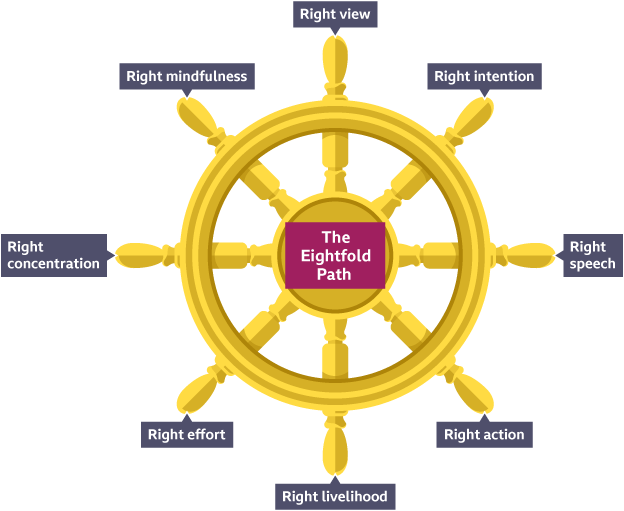
Through overcoming suffering, a Buddhist can achieve nibbana
. The Eightfold Path contains eight practices that a Buddhist must do to
reach nibbana. The Eightfold Path is often shown as a wheel. However, it
can also be split into three (this is known as the Threefold Way) to
allow Buddhists to understand a way to overcome suffering.
An infographic that illustrates the Buddhism Threefold Path Ethics (Sila)
Meditation (Samadhi) Wisdom (Panna)

Right speech, right action and right livelihood Right effort, right
mindfulness and right concentration Right understanding and right
intention
This is about being good and living a morally right life. Buddhists are
expected to behave in a way that is helpful, charitable and doesn’t
cause harm to others. Buddhists need to know how to meditate properly in
order to achieve enlightenment, or nibbana. Meditation helps them to
gain the wisdom that will lead to enlightenment. Buddhists need to
achieve wisdom. In order to do this, they must overcome ignorance.
Through attaining wisdom, a Buddhist will truly understand the Buddha’s
teachings and the nature of reality.
Buddhists following the Eightfold Path may choose a vocation or a career
that enables them to live according to the Threefold Way. Therefore,
they are likely to choose jobs that enable right effort and right speech
such as a charity fundraiser or a teacher. They aim to live morally
right lives in order to achieve nibbana.
 |
| 哼哈二将
This is an excellent question that gets to the heart of
the visual symbolism found in Chinese folk religion. The pair you're
referring to are not actually a "hen" and a deity named "Ha," but rather
two powerful mythological guardians.
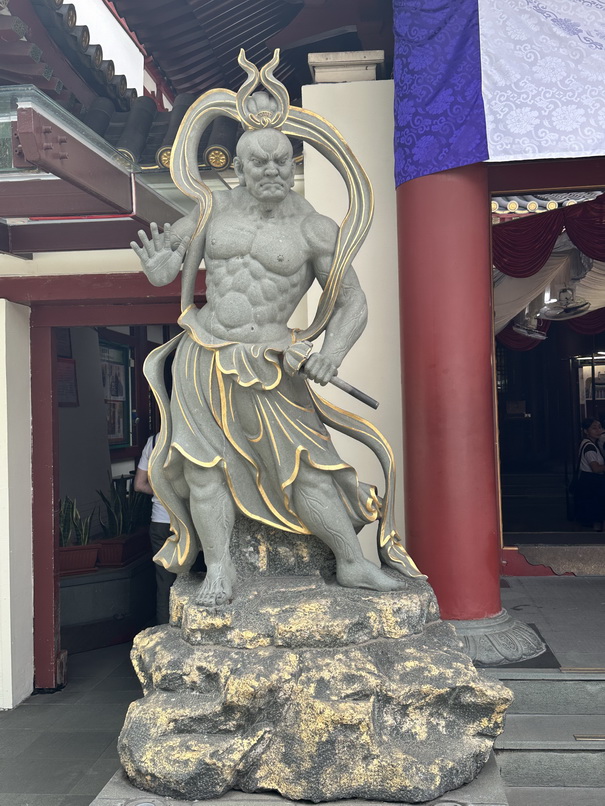 The
common names for them are: The
common names for them are: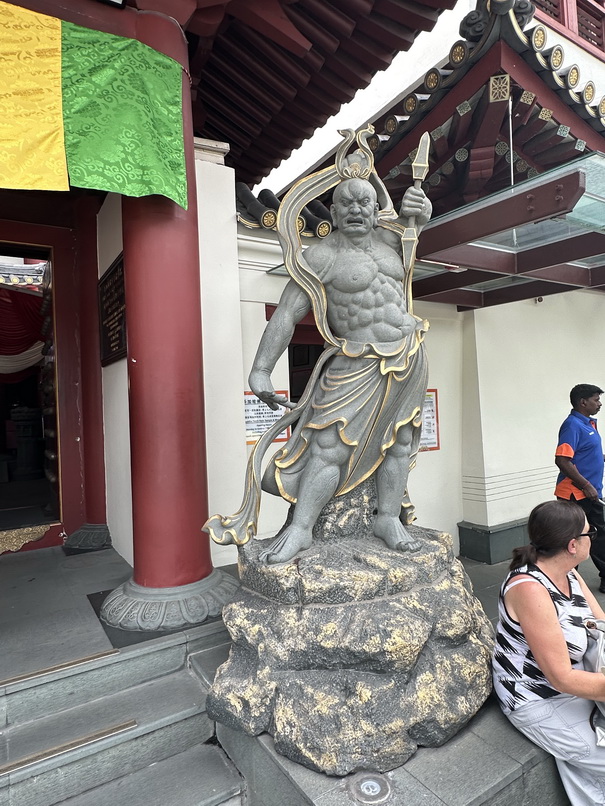
Together, they are known as Héng
Hā Èr Jiàng (哼哈二将) - The Two Generals Heng and Ha.
They are almost always the first figures you encounter,
standing guard on either side of the main entrance gate (the Shānmén 山门)
of a Chinese Buddhist or Taoist temple.
The Background Story and Origin
The story of Heng and Ha originates from the classic
Chinese novel "The Investiture of the
Gods" (Fēng Shén Yǎnyì 封神演义). This 16th-century text
is a foundational work of Chinese mythology, blending history, fantasy,
and theology to explain the origins of many deities.
In the novel, they were originally two mortal generals
fighting on the side of the Shang Dynasty (the corrupt side the heroes
are fighting against):
-
General Zheng Lun
(郑伦) - Later became Heng:
-
He was a commander under the cruel King Zhou of Shang.
-
He had a magical ability: he could snort
(hēng) two beams of white light from his
nostrils. This white light would capture the enemy's soul,
causing them to fall into a stupor, making them easy to defeat.
-
General Chen Qi (陈奇) - Later
became Ha:
-
He was another formidable general of the Shang forces.
-
His power was similar but different: he could open his mouth
and bellow (hā) a
jet of yellow gas. This yellow gas would also capture the
enemy's soul, causing them to fall unconscious.
The two generals were fated enemies, and in the story,
they eventually fought each other to a standstill and both died. After
the cosmic conflict was over, Jiang Ziya, the orchestrator of the new
divine order, performed the "Investiture of the Gods." He posthumously
enfeoffed them as divine guardians, granting them the titles:
Their function was to guard the gates of Buddhist
temples, a role they have filled ever since.
Symbolism and Role in the Temple
-
Guardians of the
Dharma: In Buddhism, they are seen
as Dvarapalas (guardian kings). They protect the sacred
temple grounds (Sangharama) from evil spirits, demons, and
negative influences. They are the first line of defense, ensuring
the purity of the space within.
-
Symbolic Postures and Powers:
-
Their fierce, muscular appearances and aggressive stances are
meant to intimidate malevolent forces.
-
Their powers are deeply symbolic. The breath (qi 气) is
the fundamental energy of life. Heng and Ha represent the
control over this vital energy, with one expelling it through
the nose and the other through the mouth. Together, they
symbolize the control over all aspects of breath and spirit,
able to subdue any spiritual threat.
-
A Warning and a Welcome: For
worshippers, they serve as a reminder to leave behind worldly
desires and evil thoughts before entering the sacred space. They are
not meant to be frightening to devout humans but are a warning to
negative intentions. Passing between them symbolizes leaving the
profane world and entering a sacred one.
How to Identify Them at the Temple
When you visit a temple, you can tell them apart by their
signature gestures:
-
General Heng (哼 -
The "Ha" / Snorter):
-
He is usually on the left side as
you face the gate.
-
His mouth is closed or
grimacing, and he often holds a vajra (a
diamond club) or a weapon. He is the one who "snorts" through
his nose.
-
General Ha (哈 - The "Hen" /
Blower):
-
He is usually on the right
side as you face the gate.
-
His mouth is wide open,
as if in the act of bellowing his yellow gas. He often holds a
ring or another type of weapon.
In summary, the "hen
and ha" deities are not a chicken and a god, but a powerful pair of
guardian generals, Heng and Ha. Their story comes from Chinese
mythological fiction, and their role is to protect the temple,
symbolizing the power to subdue evil spirits and guard the threshold
between the mundane and the sacred.
|
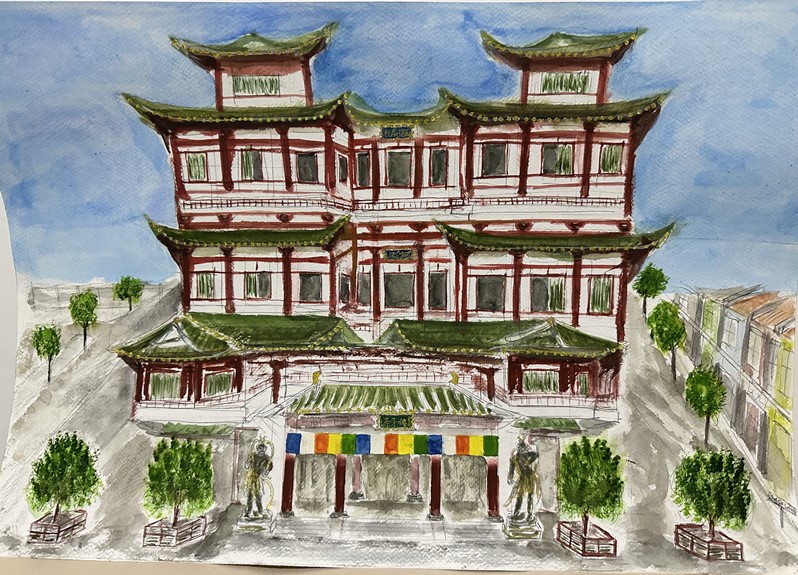
![]()
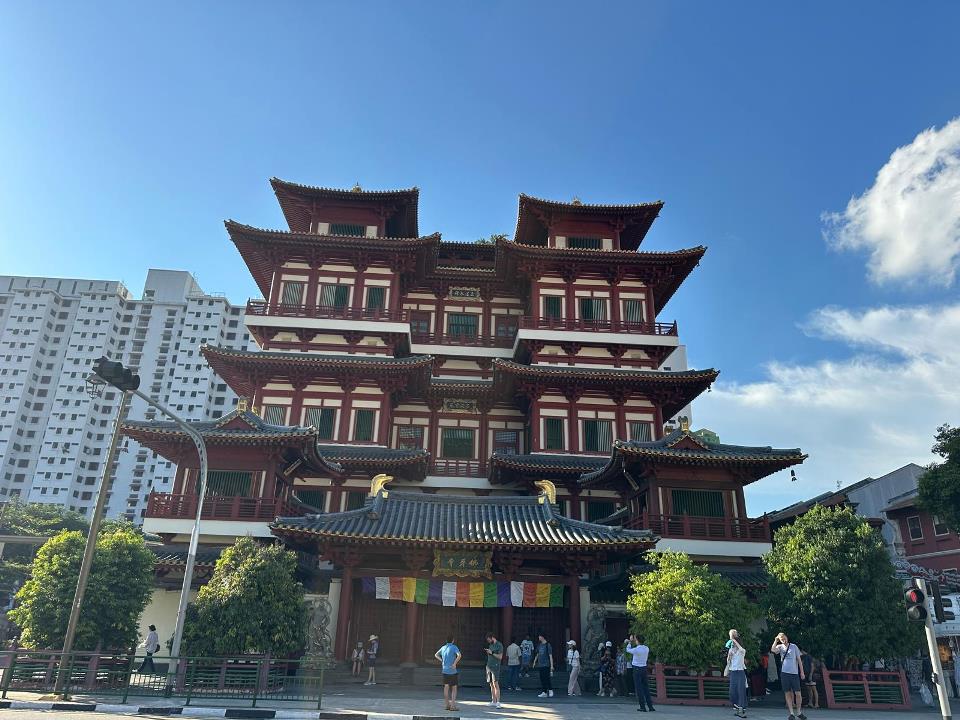
.jpg)



